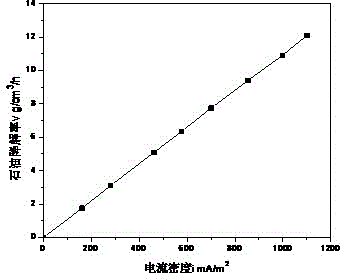Seafloor sediment biological fuel cell sensor system for in-situ monitoring of organic pollutant degradation
A biofuel cell and organic pollutant technology, applied in biochemical fuel cells, instruments, measuring devices, etc., can solve the problems of low degradation rate and difficulty in in-situ monitoring, so as to accelerate the speed of environmental restoration, reduce costs, reduce effect of error
- Summary
- Abstract
- Description
- Claims
- Application Information
AI Technical Summary
Problems solved by technology
Method used
Image
Examples
Embodiment 1
[0027] Example 1 : This implementation case is used to illustrate the application of the biofuel cell sensor system in the seabed sediment layer to in-situ monitoring of the degradation effect of seabed petroleum pollutants.
[0028] The carbon fiber negative electrode 1 (length 1m, width 1m, thickness 0.2m, composed of multiple titanium carbon fiber brushes) and the reference electrode saturated calomel electrode 3 of the seabed sediment biofuel cell were placed in the sea mud, at a distance from the sea mud / The seawater interface is 30cm; the battery graphite rod cylindrical positive electrode 2 (diameter 0.5m, height 1m) is suspended in seawater, 20cm away from the sea mud / seawater interface; it is connected by wires to form a battery. In order to reduce the influence of polarization, adjust the rheostat box 4 connected in series between the positive and negative poles of the battery to 1000 ohms, connect the battery to a data acquisition instrument 5, place it on the u...
Embodiment 2
[0030] Example 2: This implementation case is used to illustrate the application of the biofuel cell sensor system in the seabed sediment layer to in-situ monitoring of the degradation effect of seabed petroleum pollutants.
[0031] The carbon felt negative electrode 1 (length 1m, width 1m, thickness 0.2m) and the reference electrode saturated calomel electrode 3 of the seabed sediment biofuel cell are placed in the sea mud, 60cm away from the sea mud / sea water interface; the battery graphite rod cylinder The shape positive electrode 2 (diameter 0.5m, height 1m) is suspended in seawater, 20cm away from the interface of sea mud / seawater; it is connected by wires to form a battery. In order to reduce the influence of polarization, adjust the rheostat box 4 connected in series between the positive and negative poles of the battery to 1000 ohms, connect the battery to a data acquisition instrument 5, place it on the upper part of the sea mud / seawater interface, and pass through ...
Embodiment 3
[0033] Example 3 : This implementation case is used to illustrate the application of the biofuel cell sensor system in the seabed sediment layer to in-situ monitoring of the degradation effect of seabed petroleum pollutants.
[0034] The carbon rod negative electrode 1 (length 1m, width 1m, thickness 0.2m) and the reference electrode saturated calomel electrode 3 of the seabed sediment biofuel cell are placed in the sea mud, 100cm away from the sea mud / seawater interface; the battery graphite rod cylinder The shape positive electrode 2 (diameter 0.5m, height 1m) is suspended in seawater, 20cm away from the interface of sea mud / seawater; it is connected by wires to form a battery. In order to reduce the influence of polarization, adjust the rheostat box 4 connected in series between the positive and negative poles of the battery to 1000 ohms, connect the battery to a data acquisition instrument 5, place it on the upper part of the sea mud / seawater interface, and pass through...
PUM
 Login to View More
Login to View More Abstract
Description
Claims
Application Information
 Login to View More
Login to View More - R&D Engineer
- R&D Manager
- IP Professional
- Industry Leading Data Capabilities
- Powerful AI technology
- Patent DNA Extraction
Browse by: Latest US Patents, China's latest patents, Technical Efficacy Thesaurus, Application Domain, Technology Topic, Popular Technical Reports.
© 2024 PatSnap. All rights reserved.Legal|Privacy policy|Modern Slavery Act Transparency Statement|Sitemap|About US| Contact US: help@patsnap.com










